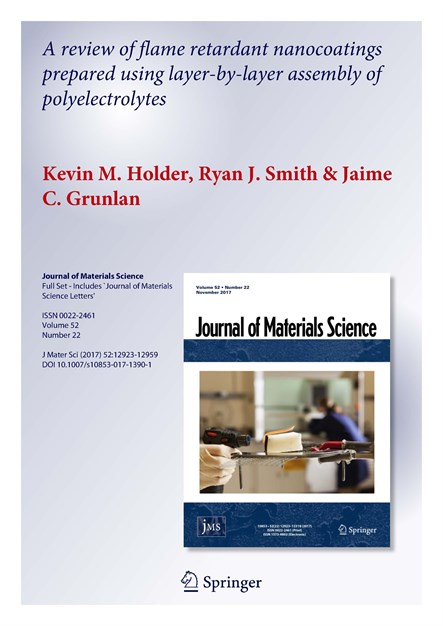Dr. Jaime Grunlan, Linda & Ralph Schmidt ’68 Professor in the Department of Mechanical Engineering at Texas A&M University; Dr. Kevin Holder, a former doctoral student in the Department of Materials Science and Engineering; and Ryan Smith, a current doctoral student in the Department of Chemistry, completed a review paper about one of the first major breakthroughs in the past few decades in this established industry – protective flame retardant nanocoatings for polymeric surfaces. This paper will be featured as the cover article of the November 2017 issue of the Journal of Materials Science.
Invented in Grunlan’s Polymer NanoComposites Laboratory at Texas A&M, these flame-retardant nanocoating treatments create an outer barrier to extinguish flames before they spread, while also addressing concerns regarding the toxicity of the flame retardant chemicals currently available.
“My group is using water-based solutions of polymers and particles such as clays, carbon nanotubes and graphene oxide to deposit thin coatings onto various polymeric substrates, such as polyurethane foam, cotton and cotton-blended fabrics to cause flame-retardant behavior,” said Grunlan “We were the first group in the world to demonstrate that the layer-by-layer deposition technique could be used to deposit very thin, very effective and environmentally benign flame-retardant coatings.”
Clay and other nanoparticle-based coatings act as thermally insulating barriers on the surface of these substrates, protecting the underlying material from further degeneration.
“Many severe fires that result in major property damage and loss of life are fueled by foam, upholstery, clothing, etc., which are very flammable,” Grunlan said. “By understanding how phosphorus and nitrogen-based chemicals, sometimes in combination with clay and other ingredients, stop fire, we can design more effective and safe flame-retardant treatments.
“Following a seminar I gave in New Orleans in 2008 at an American Chemical Society (ACS) National Meeting, and a subsequent paper in ACS Applied Materials and Interfaces in 2009, numerous research groups, government agencies and companies began studying these systems worldwide. It's a testament to how powerful and useful this technology, first conceived at Texas A&M, is to fire safety.”
Grunlan began studying this subject while working on gas barrier thin coatings for food and electronics packaging. Grunlan’s team sent coated foam to the National Institute of Standards and Technology (NIST) in 2006 and the scientists there were shocked at how the coated foam resisted their fire testing. Grunlan received funding for this work from NIST for six years, which drew interest from many companies.
Since beginning this work in 2006, Grunlan’s research group has had three patents issued, dozens of papers published and signed licensing agreements with several major corporations. They are currently working on reducing processing steps and improving flame-retardant performance and durability of these coatings to make them more favorable to commercialization.
Dr. Woo-Sik Jang, a researcher at the University of Pennsylvania, and Ian Rawson, a former student, were the first two people to work on this in Grunlan’s group. Since then, Grunlan further developed this technology with several more doctoral students and postdocs: Dr. Galina Laufer, senior engineer at PepsiCo Advanced Research; Dr. Yu-Chin Li, research and development manager at Preferred Sands; Dr. Amanda Cain, senior engineer at Huntsman; Dr. Marcus Leistner, product development specialist at ALBIS Plastic; Dr. Tyler Guin, scientist II at the Air Force Research Laboratory; and others.